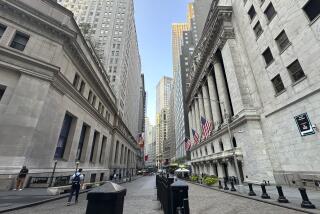Surge in Economic Indicators Points to Greater Growth
WASHINGTON — The government’s chief measure of future economic growth bounded upward by 2.1% in December, the fourth consecutive monthly increase and the largest gain in nearly four years, the Commerce Department said Tuesday.
Analysts quickly pointed out that the increase was probably inflated by several one-time-only effects, but they said it still strongly suggests greater growth this year.
Much of the surge was caused by a jump in building permits and a spate of consumer borrowing, two of 11 components in the index of leading indicators.
Picking Up Speed
Separately, the Commerce Department released two more reports reflecting an economy picking up speed at the end of last year.
New orders for non-defense manufactured goods increased 4.4% in December, the best such monthly showing since September, 1980. Also, single-family home sales jumped 12.7% in December, capping the housing industry’s best year since 1978.
Even removing the distortions that appear in December’s future economic growth index, the measure would have risen about 1%, a higher than average jump and one in line with the record of the previous three months, economists said.
The one-time effects included the onset of the new tax code and higher fees for building permits in California effective Jan. 1, which apparently encouraged a last-minute December rush there.
Buying Binge
Similarly, the spurt in consumer credit and consumer goods orders may have been spurred by end-of-year auto financing bargains and a buying binge by consumers wishing to deduct sales taxes before the new tax law became effective.
“The numbers are spectacular, but there are an awful lot of temporary flukes,” said David Wyss of Data Resources Inc., a Lexington, Mass., forecasting firm.
Nevertheless, eight of the 11 index components were up. After building permits and credit, the biggest contributors in order were manufacturers’ orders for consumer goods, changes in raw materials prices, the size of the money supply, plant and equipment orders, stock prices and the length of the workweek.
The overall 2.1% jump was the largest single monthly gain in the index since a 3.1% increase in January, 1983, in the early stages of the economy’s recovery from the steep 1982 recession.
‘Healthy’ Growth Seen
Douglas Handler of Wharton Economics, a Philadelphia forecasting firm, said that while the index may have been overstated, “even if you do the necessary discounting, the index is strong and consistent with the past two months. . . . I think you can predict healthy economic growth by the end of 1987.”
Handler pointed out that in addition to the distorted growth in some components, several business-related indexes were also up, such as plant and equipment orders and the average workweek, both slightly higher at 0.1%.
Irwin Kellner, chief economist at Manufacturers Hanover Trust Co., who has been regularly forecasting a brighter future than most other analysts, dismissed negative interpretations of the index as “contortions of bond market bulls who try to explain away every positive development.”
He pointed out that the index has now moved upward a strong 7.2% over the last year. “If that ain’t strength, I don’t know what is,” Kellner said.
Unreliable Measure
The only negatives were a small increase in average weekly claims for unemployment insurance and a small decline in new business formations--a component that the Commerce Department says it plans to drop from the index this year because it has become an unreliable measure of future economic change. One indicator, length of delivery time on business orders, was unchanged.
In the Commerce Department report on non-defense manufactured goods, the 4.4% increase provided a strong ending to an otherwise lackluster year.
Even with the December surge in orders, the tally of orders for all of 1986 was virtually unchanged from the year before--in real terms a slight decrease after inflation is factored in.
The December report on home sales, however, underscored a banner year for the housing industry. The 12.7% surge that month brought single-family home sales to 749,000 for all of 1986, up 8.9% from the previous year.
The average price of a new home was $122,600, a record, but mortgage rates have fallen to 10-year lows, making home buying more affordable.
More to Read
Inside the business of entertainment
The Wide Shot brings you news, analysis and insights on everything from streaming wars to production — and what it all means for the future.
You may occasionally receive promotional content from the Los Angeles Times.










